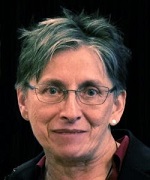This blog welcomes guest posts from SPM members on relevant topics. This is a blog post by Annette McKinnon, an e-patient in Canada. Annette is an enthusiastic advocate for patient inclusion in research and healthcare decision making. She has had rheumatoid arthritisfor the past 30 years, and has  a background in market research. She attended the Stanford Medicine X Conference in 2014 as an ePatient Scholar, and in 2013 and 2014 was moderator of the Reaching Out With Arthritis Research (#eROAR) tweetchat for the Arthritis Patient Advisory Board of ARC (Arthritis Research Canada).
a background in market research. She attended the Stanford Medicine X Conference in 2014 as an ePatient Scholar, and in 2013 and 2014 was moderator of the Reaching Out With Arthritis Research (#eROAR) tweetchat for the Arthritis Patient Advisory Board of ARC (Arthritis Research Canada).
She sits on the Board of Directors for the Sjogren’s Society of Canada, and is a volunteer Health Mentor for the Centre For Interprofessional Education in Ontario, a member of Patient Partners in Arthritis and the Canadian Arthritis Patient Alliance. She tweets as @anetto and blogs about health related issues at “Your Gold Watch – Rheutired“
Late last year I was pleased to be invited to attend a conference called “Reaching the Summit: Leading the way from Interprofessional Education to Practice”. Having patients included with educators and practitioners meant that the healthcare stakeholders sitting around the table were representative of more of the members involved in the health team.
It was a little disconcerting when I looked back at the list of Summit Registrants prior to writing this post and saw that under the title and the occupation columns the patients were all listed as “Patient Guests” in both columns. That seems to imply that our place is not secure – maybe it isn’t a given that patients will always be invited to participate.
At the event a large part of the afternoon was spent in breakout sessions, each one with a patient representative. The teams were composed of people working in hospital administration, in medical education, clinicians, allied professionals and, as at the IDEO Design Challenge, the variety of opinions led to strong and useful conclusions and strategies.
At one point in the session I commented that the very words ‘inter-professional collaboration’ on their own seem to exclude patients. With that as the conference description I did not feel originally that I belonged in this discussion. It was wonderful to hear that others at the table agreed with me. In fact the facilitator of our session had written a paper on that topic titled Interprofessional jargon: How is it exclusionary. Cultural determinants of language use in health care practice!
With exclusion on my mind, I transcribed this sentence from a webinar on YouTube on the topic of Patient and Family Engagement:
“In summary, we can think of patient and family centered care as the umbrella term for the approach or, as then is implicit, the container concept that encompasses the elements and arranges the activities that come to define patient engagement, towards the ultimate aim of improving patient experiences and outcomes.”
It does not sound like “Let’s engage the patients!” language to me.
Here’s a definition of Patient Experience from The Beryl Institute:
“The sum of all interactions, shaped by an organization’s culture, that influences perceptions across the continuum of care.”
I wonder if healthcare organizations give much thought to engaging patients and families so they can provide input and influence decisions before they are made.
This blog post by Dr. Matthew Katz, on the Mayo Clinic website, E-Patients Deserve E-Doctors: Addressing the Needs of Both to Make Healthcare Better for Everyone makes great points. Here are a few quotes from his excellent post:
“Empowering patients and doctors ensures they can work together. If patients and doctors don’t stand up for themselves, other stakeholders (e.g. hospitals, insurers, industry) may unwittingly make things worse.
Thoughtful, vocal patients, caregivers and doctors should stand together. Even when we disagree, we can respect our differences while working toward solutions, both in clinic and for the health care system. We need each other. And if we support each other, the entire health care system will be the better for it.”
I encourage you to read the whole post. The idea of doctors and patients as natural allies seems like the right choice to make.






Recent Comments